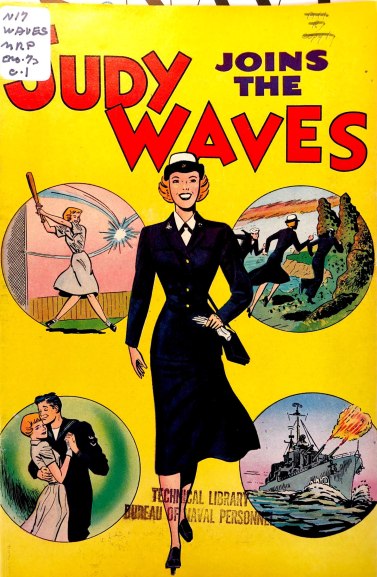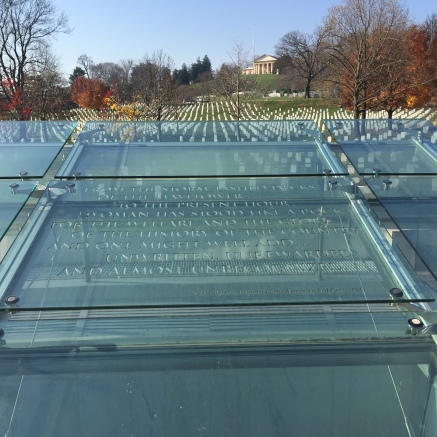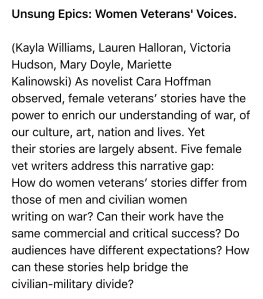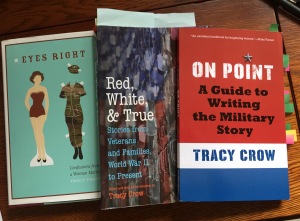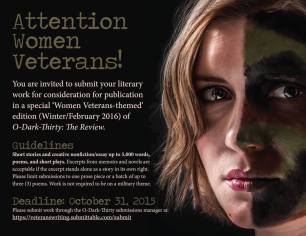Since Cara Hoffman wrote her op-ed “The Things She Carried” for the New York Times in 2014, critics have either pointed out the “absence” of women veterans’ narratives in the canon of war literature, or wondered what female authors today’s women veterans who choose to write about war can turn to as models – perhaps suggesting women who served before the current generation never wrote anything worth imitating or attempting to surpass. It is past time to start correcting two common misperceptions about women veterans and literature: first, that women veterans’ voices are almost completely absent in the literary world; and second, that women veterans who wish to write have only male role models for their writing.
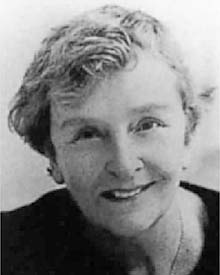
Mary Lee Settle
I’d like to tackle that second misperception with this post. Women veterans have our very own distinguished literary matriarch – Mary Lee Settle: an American woman, wife of a British soldier and mother of a young son, who enlisted in the Royal Women’s Auxiliary Air Force (WAAF) in World War Two. She wrote twenty-three books, fifteen of them novels; in 1978, she won the National Book Award for Fiction with her novel Blood Tie; and in 1980 she founded the prestigious Pen/Faulkner Award for Fiction, the largest peer-juried literary award in America. Her memoir All the Brave Promises: Memories of Aircraft Woman 2nd Class 2146391 is a short but perceptive, candid, and lyrical exploration of her experience of military service in wartime England.
Settle proves that even women who served in support roles can make unique and important contributions to the literature of war (and to literature in general). Women veterans writing memoir would do well to examine her work as an example of the unique perspective that women can bring to the discussion of war. Settle’s memoir is compelling despite not being male-centric, set in the heat of battle, heroic, or romantic. She explores themes of who really fought the war, women’s service at a time when enlistment was a violation of gender norms and expectations, fear, memory, wartime glory, and the nature of trauma with a wry voice, unsparing observation of character, and acid wit.
* * *
In January 1940, West Virginia native and Washington, D.C. socialite Mary Lee Settle went to Toronto with her English husband Rodney Weathersbee so he could volunteer for the Canadian Army. Toronto was full of British citizens who couldn’t get back to England, including English pilots who’d been sent to Canada to train away from the Blitz. There a young RAF fighter pilot trainee asked her to take his place if he were shot down. “I promised,” she said. “It was that simple.”

WAAF recruiting poster.
After she returned to West Virginia to live with her family, the young pilot was shot down – though Settle did not know at the time that he’d survived and been taken prisoner. In the summer of 1942, leaving her young son with her family, she went to Washington to try to volunteer for military service but was turned away. Eventually military attachés at the British Embassy in Washington, whom she’d met through her husband, arranged for her to enlist in the Royal Women’s Auxiliary Air Force – the WAAF.
Settle dedicates her memoir to the WAAF women of the “other ranks,” below the rank of sergeant. The book is a scathing commentary on the difference between the glamorous circles she moved in before the war (those attaché friends!) and the people who actually fought it. She’s an acute observer of character, and describes her fellow WAAFs – officer, NCO, and “other ranks” (junior enlisted) – with a wit as sharp as a Gurkha knife.
At first Settle doesn’t fit in with the women in whose company she finds herself. The difference between her body and those of the British women enlisting with her, at a Nissen hut where everyone had to strip naked for medical exams, nearly brings her to tears. Not only are their bodies malformed from poor nutrition; they seem prematurely aged. Head lice infect nearly half of them.
Settle is set apart not just by her healthy body, but by her habits. She takes a hot shower every morning while the other girls neither wash in hot water nor change their underwear for a week. She strips down to the buff every night and sleeps in pajamas. She can’t eat the heavy, starchy food. On her first liberty off post, with ten shillings’ pay in her pocket, she avoids the theaters and bars where the other girls go. She buys “USA” flashes – insignia for her uniform showing her country of origin – and some stationery and candy. Then she goes to the library to write letters.

WAAF shoulder flashes – these are Canadian; I can’t find a photo of the “USA” insignia that Settle would have worn.
When she returns to the hut she’s attacked and tossed out the door; she lands on her back in a puddle, her letters and candy destroyed. She lies in the mud swearing until two friends pick her up and carry her in, and she silences the jeering girls by displaying her new shoulder flashes. Eventually she sees changes in the British girls and begins to understand that they are becoming healthier in the WAAF while she’s losing weight and getting sick. As bad as the conditions are, they’re better than the ones from which the girls have come.
Settle verbally skewers the women she dislikes. The WAAF administrative officer who teaches the basic training sex education class looks “as if the only sex she had experienced was a flipped towel in a locker room.” And she rips into the three WAAF NCOs in her unit:
…the three lady NCO’s were almost parodies of everything we like to think is not true about the women’s forces. They were blindly autocratic, they had all the hopes but few of the attributes of femininity and, unfortunately, they were as ugly as the wicked sisters in Cinderella.
Warrant Officer Boggs was brown, lean as a snake, leather covered; she flicked her whip with a sarcasm that stung as it ridiculed – from time to time soft girls got crushes on her. Sergeant Love, on the other hand, was six feet tall and weighed nearly two hundred pounds. She, the best of the lot, had inside her bulk the longing heart of a romantic. Sergeant Smerd was just five feet tall – a tiny, sadistic bundle of wire, without flesh between her skin and her bones, her eyes agate cold. She was married to a sergeant on another station, and since her way of putting me into my place was to order me to run behind her bicycle like a dog as she rode around the station, her tiny legs pumping away, I hope they didn’t breed and train up a child.
Unfortunately, an RAF sergeant pilot on whom one of the NCOs has set her sights prefers to flirt with Settle. After a dance, she puts Settle on report for violating curfew and brings her for “trial” before a female WAAF officer, whom she describes thus:
Flight Officer Trimmingham was an ex-tennis player, a good sport and an absolutely unquestioning snob. To her a good backhand, a cultivated voice and a contempt for either abstract intelligence or woolly compassion were all a part of divine right. I’m sure she had never questioned a motive or a position in her life.
Her scorn for classism isn’t limited to her fellow WAAFs or even to the British. Her commanding officer, an RAF pilot, has dined with and been charmed by the American hostess (called the “lady”) of the Red Cross canteen in Bath. In what he expects is an act of compassion, he orders Settle to go to the canteen for dinner. This makes her homesick for an American voice, so on her next leave she follows the order.
I was stopped at the desk and told that the canteen was not for Allied troops, while the passing GI’s stared. I asked for the lady. She came roaring down the crowded hall, oh busier, busier than the lady at dinner with my CO. I explained who I was and thanked her for the message. She had, I suppose, forgotten it. She whipped out, in that edged voice Southern ladies reserve for the back rooms of their lives – not for gentlemen at dinner – that if I wanted to come to the canteen, I could put on a Red Cross uniform and work. Otherwise, the place was not for Allied other ranks to “hang out.” I thanked her, stuck in the hallway among the GI’s, some of whom had stopped to listen. For once in my life, I got the words there, instead of – impotently – later, as an esprit d’escalier.[1]
I said, “All right, and if you want to join the war sometime, I’ll lend you my uniform,” and left with my face burning.
So in London I avoided the Red Cross, knowing that inside there would be the girls I had grown up with, with their two kinds of voices.
The incident that ultimately cements her allegiance to the “other ranks” – the real turning point in the narrative – takes place on a cold Christmas night. The secret that she uncovers and what she does in response is so shocking and so moving that it must be read in its entirety. I will confess: I cried.
* * *

Allied merchant ship losses to German U-boats, 1939-1946 (Source: US Merchant Marine)
Although Settle enlisted in the WAAF in a flush of idealism, she gained an understanding of the real experience of war – one that would resonate with many veterans of more recent wars – before she even entered basic training. She crossed the Atlantic on the merchant vessel City of Delhi during the worst of the German U-boat attacks in the fall of 1942. A young Scot, an apprentice merchantman, points out the ships in their formation that are the “coffin corners,” the ships at the corners of the convoy, in most danger of attack from German U-boats. If the “coffin corners” are hit, he explains, no one stops to pick up survivors. The U-boats wait for rescue ships and sink them, too. Suddenly she understands why a Norwegian sailor had told her not to bother carrying her Mae West. That was when the fear began, she says:
It grew, as we sailed slowly that morning, grew to a level of recognition and stayed with us – fear, rolling along under us like an imagined double, an evil alter ego to our sailing. No one mentioned it except quietly to another single person or in jokes or in sudden silences that followed unfamiliar sounds.
Two weeks into their transatlantic voyage, the U-boats find their convoy. Settle thinks at first that she has dreamed the sound she heard late at night.
In the early morning….the right rear coffin corner. It was empty. I could see the other ships changing places on the horizon. By noon the corner was closed. It seemed as abstract as losing a pawn in chess. Most of the men keeping a kind of vigil along the starboard rail that morning were the merchant seamen. They said little, only watched while the convoy reclosed its square.
Later, the two corvettes escorting the convoy and her ship launch depth charges.
We were not attacked again; whatever marauder had lurked along after us was gone or sunk, and the water had closed back over where it had been as impersonally as the ship in the early morning had neatly sailed to close the convoy’s coffin corner.
In response, the passengers decided that night to put on a show. She explains: I would see this happen over and over when the event, the battle, no matter how terrible, would break the debilitating stalemate of the body in its state of war and cause a communal adrenalin rise – a precious, simple sense of being vulnerable and alive.
Afterwards, I was learning to live with fear – not a caught breath warning danger, as of a fall, but a presence – a patient, lasting undertone, an evil possibility. To look back on safety was to look back on a kind of physical innocence, an unknowing never to be regained. Gray was its color – all the fog-gray, sea-gray of rubble, of endless English days, like the inside of a brain, gray in faces, especially of women, gray joyless sex, tired gray dirty arms, fatigue-gray. All other color I remember is in contrast to this basic dim twilight gray of the war.
After basic training, Settle decides she can’t see herself being a WAAF administrative officer. She’d noticed the connection “between the morale and the machines” – the closer an airman or airwoman was to the fight, to the operations of the planes, the higher the morale. So she volunteers as soon as possible for “Signals” – to be an aircraft radio-telephone operator. She describes her shift:

Interior view of a control room with male and female personnel logging aircraft at a blackboard and on the telephone. A group with binoculars stands at a window observing the planes as they land.
Artist: Harold William Hailstone. Image courtesy of the Imperial War Museum Collection.
In our ears there was a perpetual grumbling of pilots calling to each other thinly down a long sound tunnel of distance. Over it all, striking at the fuse wires, the human element, German jamming was a curtain through which we listened, an undulating carrier wave, maddening and incessant, its efficiency defeating itself for a while because after a few weeks it, like the rumble of the planes, became a part of silence, staying insidiously always in our ears on and off the set, as if it were lodged in our brains, a small, monstrous parody of the hum of the world….On eight-hour duty we learned to point our concentrated hearing through jamming at strength 3 or 4 (5 was the loudest) like bird dogs to the tiny strength-1 sounds beyond it, answering, transmitting or receiving the clipped English without passion or person or intonation beyond the code sounds themselves, pencils flying through the logbooks before us, logging each fragment of the sound, all as impersonal as the color of the station, hearing always through the jamming and the pinpoints of dialogue the urged rumbling of the planes.
Settle was stationed at an RAF training base. The closest she came to war death there was an incident for which she felt partly responsible. On a foggy night, her shift was bringing in trainer aircraft low on fuel. In the chaos, neither she nor her relief managed to successfully relay the engine shutdown order from the flying control officer to a pilot who’d landed his Oxford trainer. A ground crewman trying to refuel the plane in the dark slipped on the wing, fell, and was decapitated by the still-turning propeller. The crewman’s head rolled past Settle in the dark like a ball, brushing her leg just as she lit a cigarette.
Later in the war, in London, she was caught on a sidewalk during a V-1 buzz bomb attack. Her recollection of the event captures the complete vulnerability and helplessness of the unarmed, and the relief of survival:
The sound tore the Kensington air. It stopped. There was complete silence. I folded toward the pavement, as slow as dreaming. The bag splayed out from my hand and hit the palings of an area-way. It spurted cigarettes and cold cream. Face down on the pavement, my head cushioned in my arms against blast, in the position of grief, I waited. My body yearned toward the protection of the concrete. It would not let me in. The air split apart in a vast yell of sound. The pavement surged up to slap my chest. There was silence, and through me, in answer to the slap, a surge of life that had halted in the waiting. I was alive….I smelled the arid flying rubble of the burst houses, but I did not look back. We did not gape at the death of other people. There was a politeness. I picked up a hot piece of shrapnel with my handkerchief. I was in the relief of life. After such recognitions, to be alive is to bear a gift, a sense of gentleness, never a right. Through the war one felt it given, over and over, as a gift.
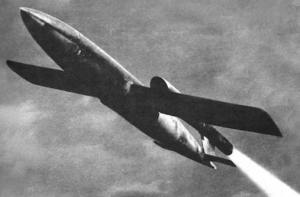
V-1 “Buzz Bomb”
* * *
Settle is as ruthlessly honest about the effects of war trauma as she is about social class and fear. She was no stranger to “adrenaline addiction” and post-traumatic stress, and she points a finger right at her generation for not discussing something so important.
What is the quality of war that so many miss and that makes peace seem dull, undirectional, lacking in zest? What is it that we, as a generation, have ‘told around’ as if it were a secret we could not name?….It was edge, a full awakening, an adrenal heightening caused by fatigue and an atavistic sense of danger that made the senses expand and extend, that made most of the young who could bear the extension of awareness miss forever that singing of the warning senses, that cat awareness….
But for the already sensitized, that awareness can be developed beyond the physical capacity to carry it, as if a machine were overloaded….The wave of deaths and suicides of highly intelligent men, the burning-out of promise, the lack of large, sustained bodies of works of art in the talented, after the war, were partly the result of this overloading, and in the rest who had been forced alive, there was a residue of sadness for what they could no longer achieve on their own. They tried to go back to peacetime, to sleep, but they had been as fully alive as wary animals, and they remembered it and wasted themselves in nostalgia.
In the already aware, it sometimes had a terrifying effect – nothing was closed – and we lived as seers, a little ashamed of what we saw. My hearing, as a result of listening through jamming on the set, became dangerously extended, uncensored….The tactile nerves were exposed – the touch wary and delicate from the running of the machines; the memory of a mane rising along one’s back in the primordial reactions to danger and the night, were a chill warning that would be left over long after the danger had passed to rise impotently, triggered by memory.
Then, in some of us, the awareness stepped over the line, went too far.
First Settle has a panic attack. Then she develops “signals shock” – because of the hours spent listening for radio transmissions through jamming, her mind begins to play tricks on her. She hears fake messages, awake and asleep, and she can no longer tell the difference between real transmissions and phantom ones. Her stomach begins to cramp and distend; her weight has dropped from 140 to 112. The station medical officer orders her to transfer out of the WAAF.
Settle ends her memoir as she is leaving post for the last time, in civilian clothing. The final paragraphs are a searing indictment of war, of those who make war, of those who believe they are running it, and of its human cost.
* * *
Settle couldn’t write her war memoir until twenty-five years after the war ended – and perhaps that distance enabled her to examine her memories critically and to speak truth to power with cutting candor. The letters I wrote my family [were] mostly false like all wartime letters from the forces (nothing else would have passed the censors), she wrote. They were, to me, a wall of lies, censorship, and books about events that I called “Ploesti raid”[2] books, as if the war were really what we had thought it would be in the beginning, in Canada, when we were young, dashing, and lively.
And she is determined not to allow the illusion to stand:
We are accused of being nostalgic. We have been. What we have remembered are events. The Second World War was, for most of us, a state, a state of war, not an event. It was a permeation, a deadening, a waiting, hard to recall. What we have told about is the terrifying relief of battle or the sweet, false relief of leave….For every “historic” event, there were thousands of unknown, plodding people, caught up in a deadening authority, learning to survive by keeping quiet, by “getting by,” by existing in secret, underground; conscripted, shunted, numbered. It took so many of them, so many of their gray days and uprooted lives. It taught them evasive ways to survive. These ways, dangerous to the community and to the spirit, have been a part of the peace.
This may be part of the reason that Settle’s memoir has not become a widely-appreciated part of the canon of war literature despite critical acclaim at the time of its publication. Her lyrical descriptions of dull grayness, bad food, helplessness and vulnerability during attacks, poor leadership and low morale, and the degrading effects of the British class system are not what we wish to remember about the “glory days” of World War Two or the people we like to call the “Greatest Generation,” especially when we are struggling to make sense of the Long Wars that followed the terrorist attacks of 9/11. But if one listens carefully to Settle, she’s saying something important: war stories that focus exclusively on heroic action and manly courage are naive, immature, even deliberate misrepresentations of the nature of war. This was a message that America didn’t want to hear when the war ended, or when her memoir was published, and perhaps – given the commercial success of movies like American Sniper – doesn’t want to hear even now.
In All the Brave Promises, Mary Lee Settle has left an intense, moving, and sometimes profound recollection of her experiences as a woman contributing to the fight against the Nazis. Women veterans who wish to write a memoir would do well to read All the Brave Promises, and to consider how and why Settle disdained tales of masculine derring-do and set a high standard for clarity and brutal honesty about the experience of war.

Mary Lee Settle (date unknown)
While others may not remember Mary Lee Settle first for her wartime service, she was very clear about its effect on her own memory and identity.
“Old telephone numbers are gone, and addresses where I centered my life, but my serial number – 2146391 – and my rank – Aircraft Woman 2nd Class – are a part of identity, a scar that I will never lose.”
____
[1] Esprit d’escalier: the predicament of thinking of the perfect reply too late.
[2] Ploesti raid: great heroism and effort expended for a strategic failure. On August 1, 1943, the US Army Air Corps launched a raid from Libyan airfields against nine Romanian oil refineries estimated to produce 1/3 of Germany’s petroleum supply. Despite the effort of the air crews, more than fifty aircraft were lost and 330 airmen killed; oil production at the Ploesti refineries was disrupted for only a few weeks.
Thanks to fellow West Virginian and colleague David Ervin of Military Experience and the Arts for introducing me to the work of Mary Lee Settle. Although I’d been curating my bibliography for two years, I hadn’t found her – perhaps I never would have.
 The Navy directed that all female yeomen be disenrolled by the end of 1919. All had been awarded the World War I Victory Medal.
The Navy directed that all female yeomen be disenrolled by the end of 1919. All had been awarded the World War I Victory Medal.

